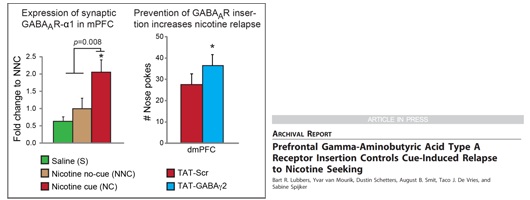
MCN PhD-student Bart Lubbers and PIs Taco De Vries and Sabine Spijker present first evidence for a molecular mechanism for relapse to nicotine seeking in the prefrontal cortex in which GABAA receptor trafficking is essential. Their findings are currently available in on-line issue of Biological Psychiatry.
Prefrontal GABAA receptor insertion controls cue-induced relapse to nicotine seeking
Smoking cues and the prefrontal cortex
Smoking-associated stimuli are a main causal factor in relapse to smoking in humans. “Similarly, in rats that learned to self-administer nicotine, the primary addictive substance in tobacco smoke. Drug seeking can be triggered by presenting them with nicotine-associated audiovisual stimuli‚, explains first author, Bart Lubbers. “Because the medial prefrontal cortex plays a central role in controlling relapse to several addictive drugs in both humans and animals, we set out to identify the molecular mechanism that mediates relapse to nicotine seeking in this area‚.
Trafficking of the GABAA receptor to limit relapse
For a number of neurotransmitter receptors commonly involved in neural plasticity, the authors determined whether expression levels in the medial prefrontal cortex were changed by relapse. “While we did not find any changes in glutamate receptors, we observed an acute upregulation of synaptic GABAA receptors‚, says Bart Lubbers. Interestingly, blocking this upregulation with a peptide interfering with the interaction between GABAA receptors and their trafficking protein GABARAP augmented relapse rates after infusion in the dorsal part of the medial prefrontal cortex (dmPFC), but not the ventral part. “Doing so, we could nicely dissect the brain areas involved in relapse to nicotine seeking‚, explains senior author prof. Taco De Vries. “Indeed, we were really excited about this‚, adds senior author prof. Sabine Spijker, “as this suggests that this form of GABAergic plasticity functions to limit relapse. This is very interesting from a therapeutical perspective, when talking about more effective smoking cessation therapies‚.
This paper can be found here.
Bart R. Lubbers, Yvar van Mourik, Dustin Schetters, August B. Smit, Taco J. De Vries, Sabine Spijker. Prefrontal GABAA receptor insertion controls cue-induced relapse to nicotine seeking
Biological Psychiatry
First published online on February 11th, 2014.
